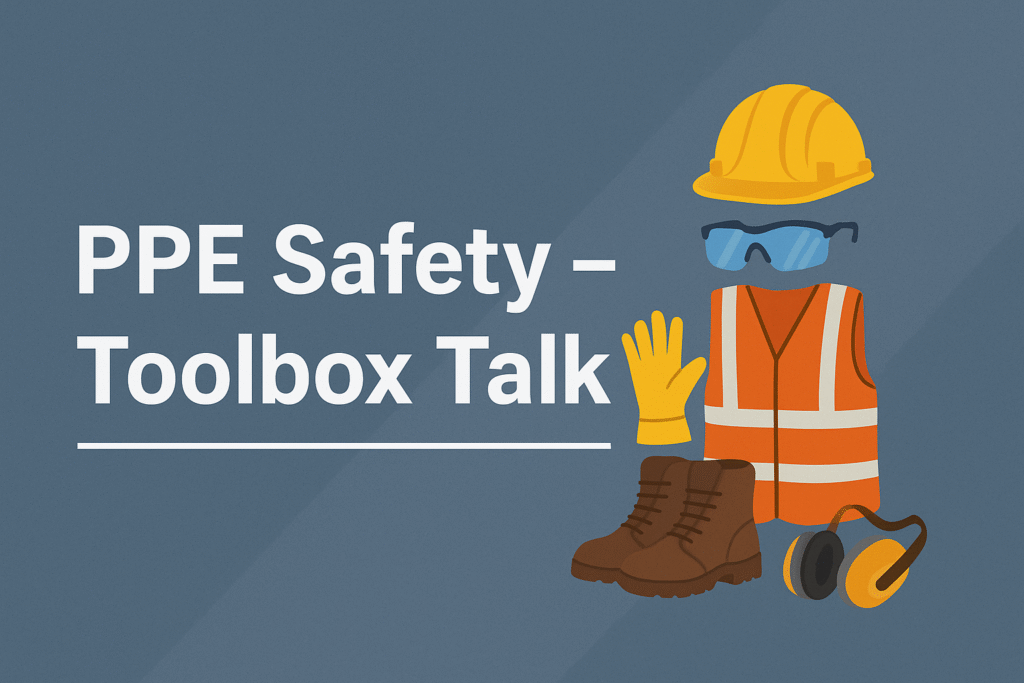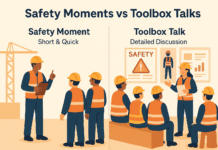
PPE Safety TBT
Good morning team,
Today’s talk is about Personal Protective Equipment (PPE) — your last line of defense against workplace hazards.
PPE is not a substitute for eliminating hazards, but when risks can’t be fully removed, PPE protects you from injury and even saves lives. Whether it’s a hard hat preventing a head injury, safety glasses protecting your eyes, or gloves guarding your hands, PPE is essential.
But here’s the thing — PPE only works if you choose the right type, wear it properly, and maintain it in good condition.
1. Why PPE Matters
- Prevents injuries from falling objects, flying debris, chemical splashes, loud noise, and more.
- Helps meet legal and site safety requirements.
- In many cases, wearing PPE is the difference between a minor incident and a life-altering injury.
2. Types of PPE and Their Purpose
2.1 Head Protection
- Hard hats protect against falling objects and overhead hazards.
- Must be worn at all times in designated areas.
- Replace if cracked or after a heavy impact.
2.2 Eye and Face Protection
- Safety glasses protect from dust, chips, and small particles.
- Goggles protect against chemical splashes.
- Face shields protect from flying debris and hot sparks (often used with glasses or goggles).
2.3 Hearing Protection
- Earplugs or earmuffs reduce noise exposure.
- Required in high-noise areas (85 dB or above).
- Noise damage is permanent — protect your hearing.
2.4 Respiratory Protection
- Dust masks filter non-toxic particles.
- Half/full-face respirators protect from toxic dust, fumes, or vapors.
- SCBA (Self-Contained Breathing Apparatus) for oxygen-deficient or toxic atmospheres.
2.5 Hand Protection
- Leather gloves for handling rough or sharp materials.
- Chemical-resistant gloves for handling hazardous liquids.
- Cut-resistant gloves for sharp tools and sheet metal work.
2.6 Foot Protection
- Safety boots with steel/composite toes protect against impact.
- Slip-resistant soles prevent falls.
- Electrical hazard boots insulate against shock.
2.7 Body Protection
- High-visibility vests ensure you are seen.
- Flame-resistant clothing for hot work.
- Chemical suits for hazardous liquid handling.
2.8 Fall Protection
- Full-body harnesses and lanyards for work at height.
- Always anchor to certified points.
3. Correct Use of PPE
- Wear PPE that fits properly.
- Follow manufacturer instructions.
- Inspect PPE before and after each use.
- Report damaged or worn PPE immediately — never use defective equipment.
4. Limitations of PPE
- PPE reduces risk but does not eliminate hazards.
- PPE can only protect the part of the body it covers — if you don’t wear it, it can’t help you.
- Wearing the wrong type can create a false sense of security.
5. Do’s and Don’ts
✅ Do:
- Choose PPE based on the hazard assessment.
- Keep PPE clean and in good condition.
- Replace PPE as recommended by the manufacturer.
❌ Don’t:
- Modify PPE to make it “more comfortable” — it could reduce protection.
- Share PPE without cleaning and sanitizing it.
- Assume PPE alone is enough — combine it with other safety measures.
6. Maintenance and Storage
- Store PPE in clean, dry areas away from direct sunlight.
- Wash and disinfect reusable PPE.
- Replace PPE at the end of its service life, even if it looks fine.
7. Real-Life Case Study
A construction worker was grinding metal without safety glasses. A small shard flew into his eye, causing permanent vision loss. The job was short, and he thought PPE wasn’t necessary.
Lesson: PPE is for every job, not just “big” jobs. Small tasks can cause serious injuries in seconds.
8. Worker Engagement – Q&A
- When should you replace a hard hat?
- Why should safety glasses be worn with a face shield?
- What is the noise level that requires hearing protection?
9. Closing Words – Bringing It Back to the Start
Alright team, we started today by saying PPE is your last line of defense. It can’t remove hazards, but it can save your life when other controls fail.
Remember — PPE works only if it’s the right type, worn correctly, and kept in good condition.
If you ever feel your PPE isn’t right for the job, speak up. We’ll get you the right gear.
Let’s protect ourselves, protect each other, and make sure everyone goes home safe.
Stay alert, stay safe, and let’s have a productive day.
Manual Material Handling Safety TBT
























